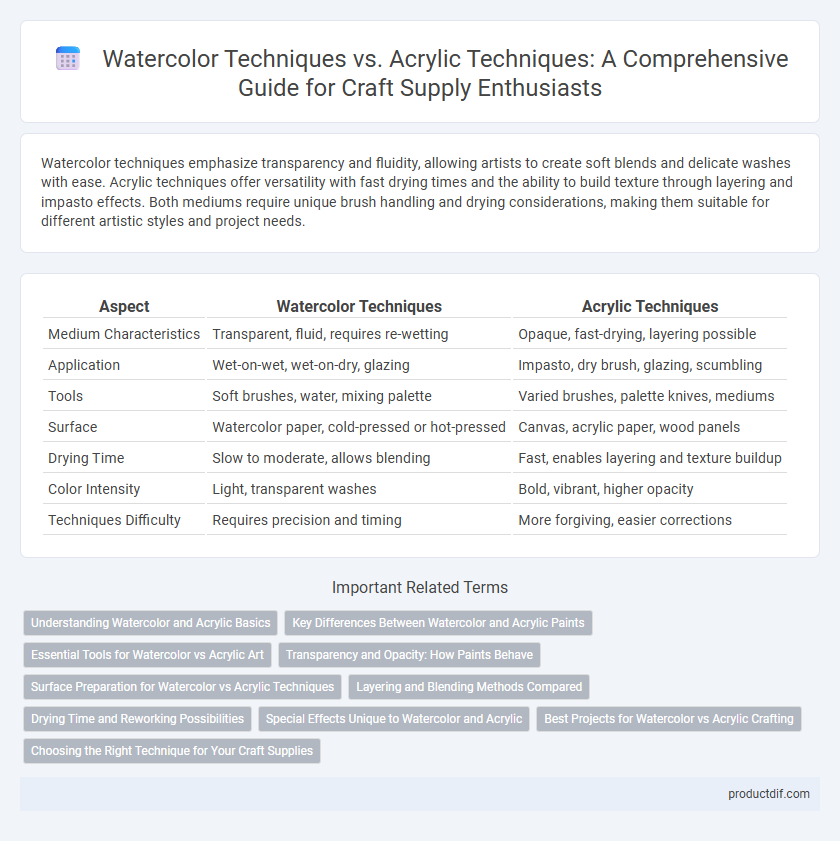Watercolor techniques emphasize transparency and fluidity, allowing artists to create soft blends and delicate washes with ease. Acrylic techniques offer versatility with fast drying times and the ability to build texture through layering and impasto effects. Both mediums require unique brush handling and drying considerations, making them suitable for different artistic styles and project needs.
Table of Comparison
| Aspect | Watercolor Techniques | Acrylic Techniques |
|---|---|---|
| Medium Characteristics | Transparent, fluid, requires re-wetting | Opaque, fast-drying, layering possible |
| Application | Wet-on-wet, wet-on-dry, glazing | Impasto, dry brush, glazing, scumbling |
| Tools | Soft brushes, water, mixing palette | Varied brushes, palette knives, mediums |
| Surface | Watercolor paper, cold-pressed or hot-pressed | Canvas, acrylic paper, wood panels |
| Drying Time | Slow to moderate, allows blending | Fast, enables layering and texture buildup |
| Color Intensity | Light, transparent washes | Bold, vibrant, higher opacity |
| Techniques Difficulty | Requires precision and timing | More forgiving, easier corrections |
Understanding Watercolor and Acrylic Basics
Watercolor techniques emphasize transparency, fluidity, and layering, using pigments diluted with water to create soft gradients and delicate washes. Acrylic techniques involve opaque, fast-drying paint that can be applied thickly for texture or thinned with water or mediums for a watercolor-like effect. Understanding the basics of watercolors requires mastering wet-on-wet and wet-on-dry methods, while acrylics demand knowledge of blending, layering, and drying time management for versatile artistic expression.
Key Differences Between Watercolor and Acrylic Paints
Watercolor paints are transparent and rely on water to create soft, flowing washes and subtle color gradients, ideal for delicate layering and light effects. Acrylic paints are opaque, fast-drying, and versatile, allowing for textured, bold applications and mixed-media techniques with ease. Key differences include drying time, opacity, and blending properties, where watercolors blend smoothly with reactivatable pigments, while acrylics form a permanent, durable finish once dry.
Essential Tools for Watercolor vs Acrylic Art
Watercolor techniques require essential tools such as high-quality watercolor paper, soft round brushes, and transparent pigments that allow for layering and blending effects. Acrylic techniques rely on thicker, more versatile acrylic paints, stiffer brushes, and primed canvases or acrylic paper to support vibrant, opaque applications. Understanding the fundamental differences in brushes, surfaces, and paint properties is crucial for mastering either medium.
Transparency and Opacity: How Paints Behave
Watercolor techniques rely heavily on transparency, allowing light to pass through the pigment and reflect off the paper, creating luminous and delicate effects. Acrylic paints exhibit greater opacity, enabling solid coverage and vibrant color layers without underlying details showing through. Understanding the behavior of these paints in terms of transparency and opacity helps artists choose the right media for blending, layering, and achieving desired visual depth in craft projects.
Surface Preparation for Watercolor vs Acrylic Techniques
Surface preparation for watercolor techniques involves using smooth, absorbent paper such as cold press or hot press watercolor paper that allows pigments to blend seamlessly and retain vibrancy. Acrylic techniques require primed surfaces like canvas or acrylic paper, where a gesso layer creates texture and prevents paint from soaking through, ensuring durability and color intensity. Proper surface preparation is crucial for maximizing pigment adherence and achieving desired effects in both mediums.
Layering and Blending Methods Compared
Watercolor techniques rely on transparent layering, allowing light to pass through multiple washes to create depth and luminosity, while acrylic techniques use opaque layering that builds texture and vibrant color density. Blending in watercolor involves wet-on-wet methods to achieve smooth gradient transitions, whereas acrylic blending often employs wet-on-dry applications or medium additives to extend drying time and facilitate seamless color mixing. Both mediums require distinct approaches to layering and blending to maximize their unique visual effects in craft projects.
Drying Time and Reworking Possibilities
Watercolor techniques offer a fast drying time that allows for quick layering and subtle blending, while acrylic techniques dry significantly faster, often within minutes, enabling rapid application but limiting extended reworking. Watercolors remain rewettable for ongoing adjustments, making them ideal for gradual color modulation, whereas acrylics form a permanent film once dry, requiring the use of retarders or specialized mediums to extend workability. Understanding these differences is crucial for artists selecting mediums for detail precision, layering complexity, and overall workflow efficiency in craft projects.
Special Effects Unique to Watercolor and Acrylic
Watercolor techniques excel in creating translucent washes and delicate gradients that produce luminous, ethereal effects unattainable with acrylics. Acrylic methods offer versatility through layering and texture manipulation, enabling bold impasto and mixed-media applications for striking visual impact. Unique to watercolor, techniques like wet-on-wet blending and granulation create unpredictable organic patterns, while acrylics specialize in durability and vivid opacity for lasting special effects.
Best Projects for Watercolor vs Acrylic Crafting
Watercolor techniques excel in projects requiring delicate blending, translucent layers, and soft gradients, making them ideal for botanical illustrations, ethereal landscapes, and portrait studies. Acrylic techniques are best suited for vibrant, textured artworks, offering durability and flexibility for mixed media, impasto effects, and bold abstract designs. Choosing between watercolor and acrylic depends on the desired finish, project complexity, and surface compatibility, with watercolors favoring paper and acrylics thriving on canvas and wood.
Choosing the Right Technique for Your Craft Supplies
Watercolor techniques offer delicate washes and subtle blending, ideal for creating soft, transparent effects in craft projects, while acrylic techniques provide vibrant colors and fast drying properties suitable for bold, textured finishes. Choosing the right technique depends on the desired outcome, surface type, and drying time preferences, with watercolor excelling on paper and acrylics being versatile on various materials. Understanding these differences ensures optimal use of craft supplies, enhancing creativity and project quality.
Watercolor Techniques vs Acrylic Techniques Infographic

 productdif.com
productdif.com